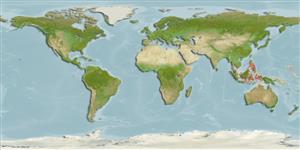Klassifizierung / Names
Namen | Synonyme | Catalog of Fishes(Gattung, Arten) | ITIS | CoL | WoRMS | Cloffa
>
Eupercaria/misc (Various families in series Eupercaria) >
Labridae (Wrasses) > Corinae
Etymology: Halichoeres: Greek, als, alis = salt + Greek, choiros = pig (Ref. 45335); hilomeni: Named for Dr. Vincent V. Hilomen of the University of the Philippines Los Baños in recognition of his efforts in obtaining collection and export permits and arranging the shipment of the type specimens to the authors..
More on authors: Randall & Allen.
Environment: milieu / climate zone / depth range / distribution range
Ökologie
seewasser riff-verbunden; tiefenbereich 1 - 3 m (Ref. 85096). Tropical
Western Central Pacific: Philippines and Malaysia.
Size / Gewicht / Alter
Maturity: Lm ? range ? - ? cm
Max length : 9.6 cm SL Männchen/unbestimmt; (Ref. 85096)
Kurzbeschreibung
Morphologie | Morphometrie
Rückenflossenstacheln (insgesamt): 9; Rückenflossenweichstrahlen (insgesamt): 12; Afterflossenstacheln 3; Afterflossenweichstrahlen: 12; Wirbelzahl: 25. This species is characterized by the following: D IX,12; A III,12; pectoral rays 14; lateral-line scales 27; head naked but nape fully scaled; most scales of straight anterior part of lateral with a middle surface tubule forming 3 short branches ending in a pore, with the middle branch usually longest; suborbital pores 10-13; gill rakers 18-20; body depth 3.15-3.6 in SL; head length (HL) 2.9-3.0 in SL; snout length 2.85-3.25 in HL; dorsal spines progressively longer posteriorly, last 3 subequal, 2.85-3.4 in HL; caudal fin moderately rounded, 1.35-1.5 in HL; upper half of body dark brown, males with 5 narrow pale bars extending from base of dorsal fin; lower half of body pale brown, the centres of scales darker; a dark brown band from upper lip to lower half of orbit, extending posterior to eye, half as broad, to base of opercular flap; 3 narrow dark bars extending dorsally from postorbital band, the first black and vertical, just behind eye, the posterior 2 bands irregular; a boomerang-shaped dark brown band extending posteriorly from behind corner of mouth across cheek; fins are translucent pale yellowish, dorsal with a broad black band across middle of first 2 membranes; rest of fin with longitudinal rows of faint, dark-edged, pale spots (3 per membrane); anal fin with a row of faint, dark-edged, pale spots along base; caudal fin with faint transverse bands; paired fins pale, the pectorals with a triangular black spot dorsally on base, narrowing to a line across remainder of base; peritoneum dark brown (Ref. 85096).
Occurs in a sheltered habitat of mixed coral, algae, sand and gravel (Ref. 85096). Found in small groups or solitary (Ref. 90102).
Life cycle and mating behavior
Geschlechtsreife | Fortpflanzung | Ablaichen | Eier | Fecundity | Larven
Distinct pairing during breeding (Ref. 205).
Randall, J.E. and G.R. Allen, 2010. Two new labrid fishes of the genus Halichoeres from the East Indies. The Raffles Bull. Zool. 58(2):281-289. (Ref. 85096)
IUCN Rote Liste Status (Ref. 130435)
Bedrohung für Menschen
Harmless
Nutzung durch Menschen
Mehr Information
Alter/GrößeWachstumLänge-GewichtLänge-LängeLängenhäufigkeitenMorphometrieMorphologieLarvenLarven Pop.Dyn.RekrutierungDichteBRUVS
ReferenzenAquakulturAquakultur ProfilZuchtlinienGenetikElectrophoresesVererbbarkeitKrankheitenVerarbeitungNutrientsMass conversion
PartnerBilderStamps, Coins Misc.LauteCiguateraGeschwindigkeitSchwimmstilKiemenoberflächeOtolithsGehirngrößeSehfähigkeit
Tools
Zusatzinformationen
Download XML
Internet Quellen
Estimates based on models
Preferred temperature (Ref.
123201): 28.5 - 29.3, mean 28.8 °C (based on 489 cells).
Phylogenetic diversity index (Ref.
82804): PD
50 = 0.5000 [Uniqueness, from 0.5 = low to 2.0 = high].
Bayesian length-weight: a=0.00955 (0.00451 - 0.02020), b=3.09 (2.92 - 3.26), in cm total length, based on LWR estimates for this Genus-body shape (Ref.
93245).
Trophic level (Ref.
69278): 3.4 ±0.5 se; based on size and trophs of closest relatives
Fishing Vulnerability (Ref.
59153): Low vulnerability (10 of 100).
